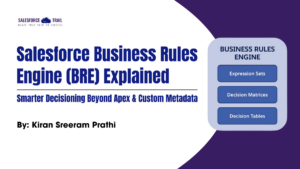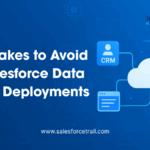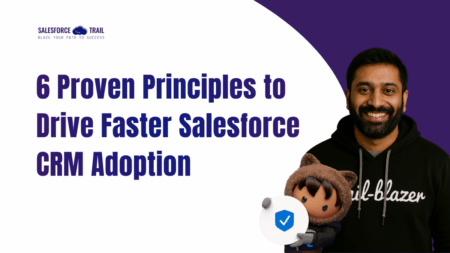Is your team spending too much time on repetitive tasks? With Salesforce Workflow Automation, you can free up time, reduce errors, and make sure everything flows smoothly. Workflow automation helps Salesforce users automatically handle simple tasks, so your team can focus on what’s important. In this guide, we’ll go through five easy tips to make workflow automation work for you. Let’s jump in!
What is Salesforce Workflow Automation?
Salesforce Workflow Automation is a feature in Salesforce that automatically completes tasks for you. This means that instead of doing every little task by hand, you can set up rules so Salesforce handles it for you. For example, when a customer fills out a form, Salesforce can automatically send a “thank you” email. With workflow automation, your team can be more efficient without extra work.

Automate Task Assignments to Keep Things Moving
Does your team get stuck waiting for someone to assign tasks? With Salesforce, you can automate task assignments, so everyone knows what they should be working on without waiting. For instance, if a new lead (potential customer) comes in, you can set up Salesforce to assign it immediately to the right team member based on location, type, or priority.
By automating task assignments, your team spends less time figuring out who does what. Instead, Salesforce does the assigning, so tasks don’t get missed. This keeps everyone on track and helps your team respond faster.
Speed Up Approvals with Automation
Salesforce has a feature called “Approval Processes” that helps with tasks that require someone’s approval, like discounts, budgets, or project plans. With approval workflows, you can set up a step-by-step process that automatically sends requests to the right people.
Tip: Set up an approval process that works for your team. For example, create a rule where any discount over a certain amount is sent to a manager for approval. Salesforce will handle the routing and notify the manager to approve or deny it.
Why It Helps: Approval processes keep things moving quickly, ensuring the right person reviews and approves requests on time.
Keep Everyone in the Loop with Automated Notifications
Good communication is key to success. With Salesforce, you can set up automated notifications to make sure everyone is always informed. For example, you can set up Salesforce to notify team members when a deal closes or when a lead moves to the next stage.
Let’s say a customer request moves to “urgent” Salesforce sends a notification to your support team. Or, when a sales deal is nearing a close, a notification can go to the sales team for final preparation.
These notifications keep everyone on the same page and eliminate the need to send updates manually. By automating notifications, your team always knows what’s going on, helping them stay organized and productive.
Quick Tip: Use email templates in Salesforce to make your notifications look more professional and consistent.

Use Workflow Rules to Update Data Automatically
Keeping data accurate by hand can take a lot of time and can lead to mistakes. Salesforce Workflow Rules let you update data automatically based on certain actions. For instance, when a sale is closed, a rule can change the opportunity status to “Closed Won” without needing you to do anything.
Tip: Identify important data fields that need to be kept up-to-date and create workflows to manage those updates. For example, when a lead becomes a customer, a workflow can change its status in Salesforce without manual input.
Why It Helps: Automatically updating data keeps your records accurate, making it easier to make smart business decisions.
Make Customer Follow-Ups Easy with Automatic Task Creation
Staying connected with customers is essential. Salesforce Workflow Automation can create follow-up tasks for you and your team. For example, after completing a sale, a follow-up task can be set up for a team member to reach out a few weeks later.
Tip: Use workflows to create follow-up tasks for important customer milestones, like when a sale closes or a service is delivered. Salesforce can assign these tasks to the right team member and even set reminders so no one forgets.
Why It Helps: Automated follow-ups make sure each customer feels valued and supported, improving customer satisfaction.
Why Use Salesforce Workflow Automation?
Using Salesforce Workflow Automation provides several benefits, such as:
- Saving Time: By automating simple tasks, you have more time for meaningful work.
- Fewer Errors: Automated data updates reduce the chance of mistakes.
- Faster Response Times: Notifications and follow-up tasks mean no customer or lead is overlooked.
- Better Productivity: Your team spends less time on routine work, giving them more time for tasks that require creative thinking
Wrapping Up: Start Using Salesforce Workflow Automation Today
Salesforce Workflow Automation can make a big difference in how your team works. By automating routine tasks, setting up easy approval processes, enabling alerts, updating data automatically, and creating follow-ups, you can save time and boost productivity.
If you’re new to automation, don’t worry! Start with a few small workflows, and as you see the benefits, you can add more advanced automation. Salesforce is user-friendly, with many resources to help you learn.
Remember: The goal of Salesforce Workflow Automation is to let you focus on what matters most growing your business and building strong customer relationships. With these tips, you’re on your way to making the most of Salesforce’s powerful automation tools.
Must Visit Links:
- LWC Platform Developer | Salesforce Jobs Opening Join Salesforce Today!
- How to Ensure Data Quality in Salesforce | Best Practices for High-Quality Data
- Top 5 Reasons to Build an AI Agent for Your Business
Resources:
- [Salesforce Developer] (https://developer.salesforce.com/)
- [Salesforce Success Community] (https://success.salesforce.com/)
For more insights, trends, and news related to Salesforce, stay tuned with Salesforce Trail
Mark Jacobes is a seasoned Salesforce expert, passionate about empowering businesses through innovative CRM solutions. With over 6 years of experience in the Salesforce ecosystem, Mark specializes in Salesforce development, integrations, and digital transformation strategies.
- Mark Jacobeshttps://salesforcetrail.com/author/markjacobes/
- Mark Jacobeshttps://salesforcetrail.com/author/markjacobes/
- Mark Jacobeshttps://salesforcetrail.com/author/markjacobes/September 15, 2025
- Mark Jacobeshttps://salesforcetrail.com/author/markjacobes/














2 Comments
Hi there would you mind sharing which blog platform you’re working with? I’m looking to start my own blog soon but I’m having a difficult time selecting between BlogEngine/Wordpress/B2evolution and Drupal. The reason I ask is because your design and style seems different then most blogs and I’m looking for something unique. P.S My apologies for being off-topic but I had to ask!
WordPress